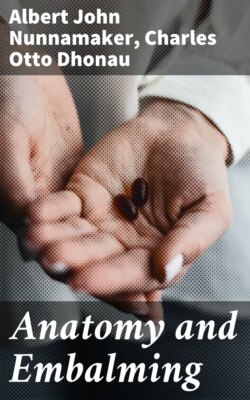Читать книгу Anatomy and Embalming - Charles Otto Dhonau - Страница 64
На сайте Литреса книга снята с продажи.
ОглавлениеCHAPTER VI. ORGANOLOGY.
Table of Contents
The body itself is divided into the upper and the lower extremities and the trunk. The upper extremities consist of the head and arms. The lower extremities consist of the legs. The trunk is that part of the body remaining after the head, arms, and legs have been severed from the body.
The Cavities.
—The body has three principal cavities: namely, the cerebro-spinal, the thoracic, and the abdominal.
The Cerebro-Spinal Cavity.
—The cerebro-spinal cavity is formed by the cranial bones, and the vertebral column. The cerebro-spinal cavity is divided into the sub-cavities, called the cranial cavity and the spinal cavity.
In the cranial cavity we find the brain. The brain is the seat of the mind, and the functions which the brain performs distinguishes man from the other animals, as man becomes a conscious, intelligent, responsible being through the action of the brain. The brain is egg-shaped, soft and yielding, closely fitting the cranial cavity. The front and top of the brain is called the cerebrum, which is the center for intelligence, reason, and will. This part of the brain is convoluted, and the depth of the convolutions to a great extent indicates the amount of intelligence.
Below the cerebrum and lying in front of the occipital bone, we find the cerebellum, which is the seat of memory and the center for the co-ordination of muscle movements. By co-ordination of muscle movement is meant that the muscles will do just what we want them to do, that they will act harmoniously, the one with the other. The condition of Saint Vitus' Dance would be an example showing a lack of co-ordination. This part of the brain is also convoluted.
Fig. 15—Brain and spinal cord.
Between the cerebrum and the cerebellum, and connecting the two, is found the pons Varolii. The word pons means bridge, and the word Varolii means to cross over. It is in this part of the brain, then, that the nerve fibers cross over to the opposite side. A person having a paralytic stroke on the right side of the body would indicate that the left side of the brain had become affected.
Joined to this is the medulla oblongata. This is the lowest part of the brain and is the connecting link between the brain and the spinal cord. The medulla controls the circulation, respiration, and deglutition (swallowing).
Closely adhering to the brain, is a delicate membrane, sinking into the convolutions, and following the surface of the brain valleys throughout. This membrane is called the pia mater. In it is found the capillaries, which supply the brain with its nutritive blood in life and with embalming fluid after death. These capillaries do not penetrate the substance of the brain, but the process is one of osmosis, absorption or transfusion. Covering the outer most part of the brain, and closely adhering to the cranial bones is a dense, tough, glistening, membrane, called the dura mater. In the dura mater is found the sinuses of the brain.
In between the pia mater and the dura mater is a delicate double membrane forming a closed sack, called the arachnoid membrane. This sac contains a serous fluid, which offers great protection to the brain. These same three membranes also cover the spinal cord, and are called all together the meninges of the brain and cord.
The brain is composed of white and gray matter. The gray matter is on the outside, and the white matter is on the inside.
The spinal cavity is formed by the bones of the vertebral column. In this spinal cavity is found the spinal cord. It is cylindrical and usually about seventeen inches in length, and extends from the medulla oblongata, to the lower border of the first lumbar vertebra, where it terminates in a slender filament of gray substance.
There originate from the under surface of the brain twelve pairs of nerves, as follows:
1. Olfactory
2. Optic
3. Motor Oculi
4. Trochlear
5. Trigeminal
6. Abducens
7. Facial
8. Auditory
9. Glosso-pharyngeal
10. Pneumogastric
11. Spinal accessory
12. Hypoglossal
There originate from the cord thirty-one pairs of nerves, as follows:
| Cervical region | 8 | pairs. |
| Thoracic region | 12 | “ |
| Lumbar region | 5 | “ |
| Sacral region | 5 | “ |
| Coccygeal region | 1 | “ |
| — | ||
| 31 | “ |
The circulation of the blood through the brain will be taken up later.
